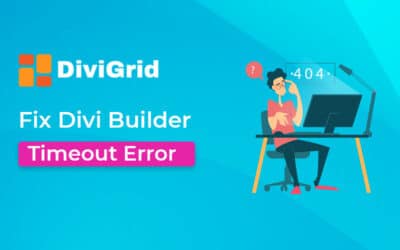Unlock expert solutions and workarounds for common Divi issues with our comprehensive guide. Whether you’re facing Divi builder loading problems, CSS glitches, or other Divi-related challenges, our guide provides detailed troubleshooting techniques to help you resolve them efficiently. Learn how to enhance your website’s performance, ensure seamless user experiences, and optimize Divi to its fullest potential. Our step-by-step instructions and expert tips will empower you to tackle any Divi issue with confidence. Dive into effective strategies for optimal Divi optimization and keep your website running smoothly. Discover the solutions you need to master Divi today.
Divi is a widely-used WordPress theme and visual page builder that offers a range of powerful features and design options. However, like any software, Divi may encounter issues that can affect its performance and functionality. In this article, we will delve into some common issues that Divi users may face and provide detailed solutions and workarounds to help resolve them
1. Blank Page or Broken Layouts in Divi
One of the issues that Divi users may encounter is a blank page or broken layouts. This can happen due to conflicts with other plugins or themes, incomplete updates, or caching issues.
Solution:
- Disable other plugins and switch to a default WordPress theme: Conflicts with other plugins or themes can sometimes cause Divi layouts to break or result in a blank page. By deactivating other plugins and switching to a default WordPress theme, you can determine if there are any conflicts. If the issue is resolved, you can then activate plugins and themes one by one to identify the conflicting one and take appropriate action.
- Disable other plugins and switch to a default WordPress theme: Conflicts with other plugins or themes can sometimes cause Divi layouts to break or result in a blank page. By deactivating other plugins and switching to a default WordPress theme, you can determine if there are any conflicts. If the issue is resolved, you can then activate plugins and themes one by one to identify the conflicting one and take appropriate action.
- Clear browser cache and server-side cache: Caching issues can sometimes cause Divi layouts to not display properly. Clear your browser cache and any server-side caching mechanisms, such as CDN or caching plugins, to ensure that the latest changes in your Divi layouts are reflected. If you want to know details about cache clearing then you can read this article:
How to Clear Your Cache: Step-By-Step Explanation - Use Divi’s built-in “Divi Safe Mode” feature: Divi comes with a built-in feature called “Divi Safe Mode” that allows you to temporarily disable all plugins and switch to a default theme, helping you identify if there are any conflicts with other plugins or themes.
- Manually recreate the layout or use a backup: If the above solutions do not work, you may need to manually recreate the layout or use a backup if you have one available. This may require reconfiguring the settings and re-adding the modules in your layout.
We will create three list grids and show how to create them with our module. So let’s see what kind of list grids we are going to create and what they look like.
2. Slow Loading Times
Solution:
- Optimize images: Large image sizes can significantly impact loading times. Optimize your images by compressing and resizing them to reduce their file size. You can use image optimization plugins or online image compression tools for this purpose.
- Minify CSS and JS files: Minifying CSS and JS files can help reduce their file size and improve loading times. You can use plugins like Autoptimize or W3 Total Cache to minify CSS and JS files in Divi.
- Limit the use of animations and effects: While animations and effects can enhance the visual appeal of your Divi layouts, excessive use of them can increase loading times. Limit the use of animations and effects to only essential elements to improve the overall loading speed of your website.
- Use a reliable hosting provider or consider using a content delivery network (CDN): The hosting provider you choose for your website can also impact its loading times. Opt for a reliable hosting provider with good server performance and consider using a content delivery network (CDN) to deliver your website’s assets from a server closer to the user, thereby reducing the loading times.
- Enable caching: Caching can significantly improve
loading times by serving static content instead of generating it dynamically every time a user visits a page. Enable caching through a caching plugin, such as W3 Total Cache or WP Rocket, to speed up your Divi website. - Remove unnecessary plugins and scripts: Unnecessary plugins and scripts can add overhead to your website and impact its loading times. Review your installed plugins and scripts and remove any that are not essential for your website’s functionality.
You can read these articles for more information. Divi Speed Optimization with Expert Tips and Techniques From DiviGrid and also from the Elegant themes website Divi Speed Optimization: the Ultimate Guide
3. Mobile Responsiveness Issues
With the increasing use of mobile devices for browsing the web, mobile responsiveness is crucial for a website’s success. Divi provides responsive design options, but users may encounter issues with mobile responsiveness.
Solution:
- Check responsive design settings in Divi: Divi offers various responsive design settings for each module and row. Make sure you have configured the responsive design settings correctly for your modules and rows to ensure they display properly on mobile devices.
- Test on actual mobile devices: Emulators and responsive design tools may not always accurately reflect how your Divi website will appear on actual mobile devices. Test your website on different mobile devices and browsers to identify any mobile responsiveness issues and make necessary adjustments.
- Use custom CSS for mobile styles: Divi allows you to add custom CSS for specific screen sizes, including mobile devices. You can use custom CSS to fine-tune the appearance of your Divi layouts on mobile devices and ensure optimal mobile responsiveness.
- Disable or adjust modules for mobile devices: Some modules in Divi may not be suitable for mobile devices or may require adjustments. You can disable certain modules or adjust their settings specifically for mobile devices to optimize mobile responsiveness.
- Use media queries to target specific devices: Media queries are CSS rules that allow you to apply styles based on screen size or device type. You can use media queries to target specific devices and apply custom styles to ensure mobile responsiveness.
4. Contact Form Not Working
Contact forms are crucial for website communication, but sometimes users may encounter issues with Divi’s built-in contact form not working properly.
Solution:
- Verify email settings in Divi: Divi requires proper email settings to send contact form submissions to your designated email address. Make sure you have configured the email settings correctly in Divi’s contact form module, including the “From Email,” “From Name,” and “SMTP” settings.
- Check spam or junk folders: Sometimes, contact form submissions may end up in the spam or junk folders of your email inbox. Check your spam or junk folders to ensure that contact form submissions are not being filtered as spam.
- Test with different email addresses: Test your contact form with different email addresses to ensure that the issue is not specific to a particular email address or email provider.
- Use a third-party form plugin: If you are still encountering issues with Divi’s built-in contact form, you can consider using a third-party form plugin, such as Contact Form 7 or Gravity Forms, as an alternative.
5. Content Formatting Issues
Content formatting issues, such as text alignment, font size, or spacing, can affect the overall appearance and readability of your Divi layouts.
Solution:
- Use the built-in design options in Divi: Divi offers a wide range of design options, including text alignment, font size, spacing, and more, that you can configure for each module and row. Make sure to utilize these built-in design options to format your content as desired.
- Use custom CSS for advanced styling: Divi allows you to add custom CSS for advanced styling. You can use custom CSS to apply specific styles to your content, such as text alignment, font size, spacing, and more.
- Check for conflicting custom CSS: If you have added custom CSS to your Divi layouts, check for conflicting CSS that may be affecting the content formatting. Sometimes, conflicting CSS can override the built-in design options in Divi, resulting in formatting issues. Identify and resolve any conflicting CSS to ensure consistent content formatting.
- Preview on different devices and browsers: Content formatting may appear differently on different devices and browsers. Preview your Divi layouts on various devices and browsers to ensure that the content formatting is consistent across all platforms.
- Follow best practices for content formatting: Follow best practices for content formatting, such as using appropriate heading tags, using consistent font sizes and spacing, and ensuring proper alignment of text and images. Consistent and well-formatted content will enhance the overall user experience on your Divi website.
6. Cross-Browser Compatibility Issues
Different browsers may interpret CSS and JavaScript differently, leading to cross-browser compatibility issues. Divi layouts may appear differently or not function properly on certain browsers.
Solution:
- Test on multiple browsers: Test your Divi website on multiple browsers, including popular ones like Chrome, Firefox, Safari, and Edge, to identify any cross-browser compatibility issues. Make necessary adjustments to ensure that your Divi layouts display and function properly on all major browsers.
- Use vendor prefixes for CSS properties: Different browsers may require different vendor prefixes for certain CSS properties. Use vendor prefixes to ensure that your CSS is interpreted correctly across different browsers. For example, use “-webkit-” for Chrome and Safari, “-moz-” for Firefox, and “-ms-” for Internet Explorer.
- Avoid using browser-specific CSS or JavaScript: Avoid using CSS or JavaScript that is specific to a particular browser, as it may not be supported by other browsers. Stick to standard CSS and JavaScript that is supported by all modern browsers to ensure cross-browser compatibility.
- Test on older browser versions: Some users may still be using older versions of browsers that may not fully support the latest CSS or JavaScript features. Test your Divi layouts on older browser versions to identify any compatibility issues and make necessary adjustments.
7. SEO and Meta Data Issues
SEO (Search Engine Optimization) is crucial for improving the visibility of your Divi website in search engine results. However, Divi may have some SEO and meta data issues that need to be addressed.
Solution:
- Optimize meta titles and descriptions: Meta titles and descriptions are essential for SEO. Make sure to optimize the meta titles and descriptions for each page or post on your Divi website to include relevant keywords and accurately describe the content.
- Use SEO plugins: Divi is compatible with popular SEO plugins like Yoast SEO and All in One SEO Pack. Use these plugins to further optimize your Divi website for SEO, including generating XML sitemaps, adding meta tags, and optimizing social sharing settings.
- Check for duplicate content: Duplicate content can negatively impact your website’s SEO. Check for duplicate content issues within your Divi website, such as duplicate pages or posts, and resolve them to ensure that search engines properly index your content.
- Optimize images: Large image files can slow down your website’s loading times and affect SEO. Optimize your images by compressing them without compromising their quality, and add relevant alt text to improve your website’s SEO.
- Check for broken links: Broken links can negatively impact your website’s SEO and user experience. Regularly check for broken links within your Divi website and fix them to ensure smooth navigation and better SEO.
8. Lack of Customization Options
Divi is known for its flexibility and customization options, but users may still encounter limitations in terms of customization.
Solution:
- Utilize child themes: Divi allows you to create child themes, which are independent themes that inherit the functionalities of the parent Divi theme. Use child themes to customize your Divi website beyond the default options provided by Divi. With child themes, you can add custom CSS, JavaScript, and other modifications to achieve the desired customization.
- Use custom code modules: Divi allows you to add custom code modules where you can insert your own HTML, CSS, and JavaScript code. Utilize these custom code modules to add additional customization to your Divi layouts.
- Explore third-party plugins and extensions: Divi has a vibrant community of developers who create plugins and extensions that extend the functionality of Divi. Explore and utilize third-party plugins and extensions to enhance the customization options of your Divi website.
- Modify Divi templates: Divi provides pre-designed templates for various page types, such as blog posts, portfolio items, and contact forms. However, these templates may not always meet your specific design requirements. Modify Divi templates by customizing the layout, design, and content to achieve the desired look and feel.
- Customize using global settings: Divi offers global settings that allow you to customize the design elements across your entire website, such as fonts, colors, and spacing. Utilize these global settings to create a consistent design theme throughout your Divi website.
9. Support and Community Resources
Divi has a large and active community of users and developers who can provide support and resources to help you overcome any challenges or issues you may encounter.
Solution:
- Utilize Divi documentation: Divi provides comprehensive documentation that covers various aspects of using the theme, including tutorials, guides, and troubleshooting tips. Refer to the documentation to find solutions to common issues or learn how to use specific features.
- Join the Divi community forums: Divi has an active community forum where users and developers share their experiences, insights, and solutions to common issues. Join the community forums to connect with other Divi users and seek help or advice when needed.
- Seek professional support: If you encounter complex issues or challenges that require professional assistance, consider seeking support from Divi’s official support team or hiring a Divi developer or designer. They can provide expert guidance and solutions to help you overcome any obstacles.
- Follow Divi blogs and tutorials: Divi has an active blog and tutorial section on their website that provides valuable insights, tips, and tutorials on how to use Divi effectively. Follow the Divi blogs and tutorials to stay updated with the latest features, best practices, and solutions to common issues.
Conclusion:
Troubleshooting common Divi issues requires a systematic approach and a good understanding of potential problem areas. By keeping your WordPress and Divi installations updated, checking for plugin conflicts, and optimizing your server settings, you can mitigate many common problems.
Divi is a powerful and flexible WordPress theme that offers a wide range of design and customization options. However, like any other theme, it may come with its own set of challenges and issues. By following the solutions mentioned in this article, you can overcome common issues with Divi and create a visually stunning and highly functional website that meets your unique requirements. Remember to regularly update Divi and its plugins, follow best practices for content formatting and SEO, and utilize the support and community resources available to make the most out of Divi and create an outstanding online presence for your business or brand.











0 Comments